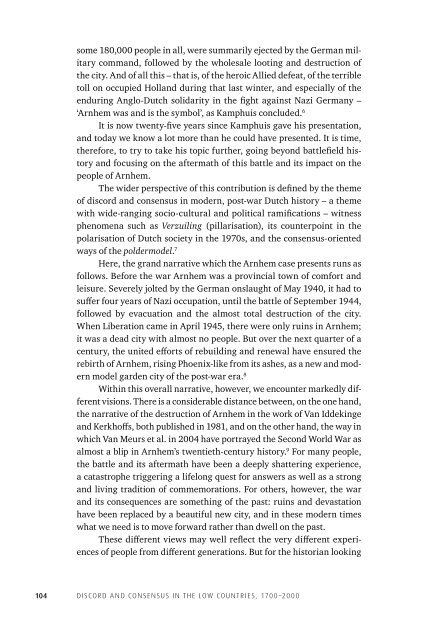Discord Consensus
7aze300jFJo
7aze300jFJo
Create successful ePaper yourself
Turn your PDF publications into a flip-book with our unique Google optimized e-Paper software.
some 180,000 people in all, were summarily ejected by the German military<br />
command, followed by the wholesale looting and destruction of<br />
the city. And of all this –that is, of the heroic Allied defeat, of the terrible<br />
toll on occupied Holland during that last winter, and especially of the<br />
enduring Anglo-Dutch solidarity in the fight against Nazi Germany –<br />
‘Arnhem was and is the symbol’, as Kamphuis concluded. 6<br />
It is now twenty-five years since Kamphuis gave his presentation,<br />
and today we know a lot more than he could have presented. It is time,<br />
therefore, to try to take his topic further, going beyond battlefield history<br />
and focusing on the aftermath of this battle and its impact on the<br />
people of Arnhem.<br />
The wider perspective of this contribution is defined by the theme<br />
of discord and consensus in modern, post-war Dutch history –a theme<br />
with wide-ranging socio-cultural and political ramifications –witness<br />
phenomena such as Verzuiling (pillarisation), its counterpoint in the<br />
polarisation of Dutch society in the 1970s, and the consensus-oriented<br />
ways of the poldermodel. 7<br />
Here, the grand narrative which the Arnhem case presents runs as<br />
follows. Before the war Arnhem was a provincial town of comfort and<br />
leisure. Severely jolted by the German onslaught of May 1940, it had to<br />
suffer four years of Nazi occupation, until the battle of September 1944,<br />
followed by evacuation and the almost total destruction of the city.<br />
When Liberation came in April 1945, there were only ruins in Arnhem;<br />
it was a dead city with almost no people. But over the next quarter of a<br />
century, the united efforts of rebuilding and renewal have ensured the<br />
rebirth of Arnhem, rising Phoenix-like from its ashes, as a new and modern<br />
model garden city of the post-war era. 8<br />
Within this overall narrative, however, we encounter markedly different<br />
visions. There is a considerable distance between, on the one hand,<br />
the narrative of the destruction of Arnhem in the work of Van Iddekinge<br />
and Kerkhoffs, both published in 1981, and on the other hand, the way in<br />
which Van Meurs et al. in 2004 have portrayed the Second World War as<br />
almost a blip in Arnhem’s twentieth-century history. 9 For many people,<br />
the battle and its aftermath have been a deeply shattering experience,<br />
a catastrophe triggering a lifelong quest for answers as well as a strong<br />
and living tradition of commemorations. For others, however, the war<br />
and its consequences are something of the past: ruins and devastation<br />
have been replaced by a beautiful new city, and in these modern times<br />
what we need is to move forward rather than dwell on the past.<br />
These different views may well reflect the very different experiences<br />
of people from different generations. But for the historian looking<br />
104<br />
DISCORD AND CONSENSUS IN THE LOW COUNTRIES, 1700–2000


